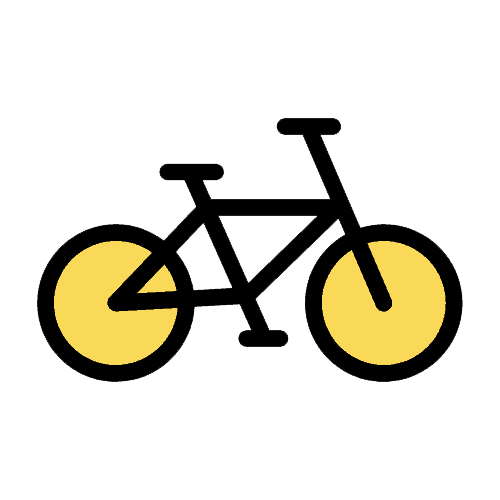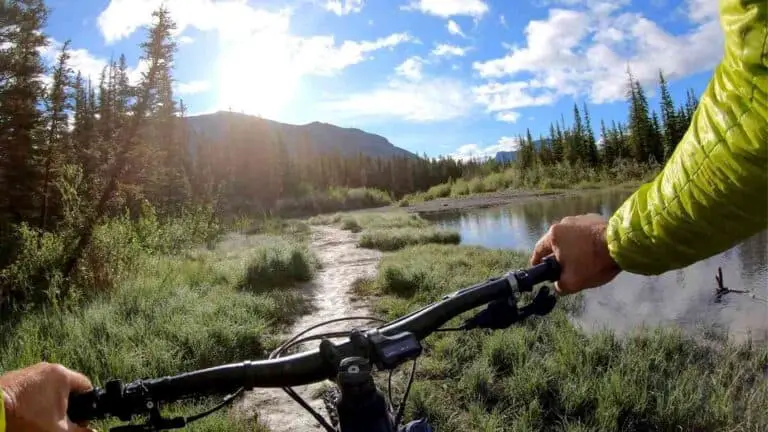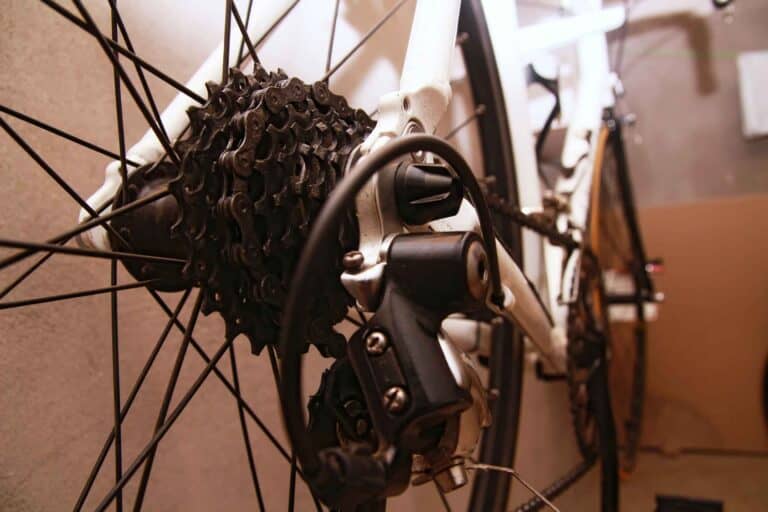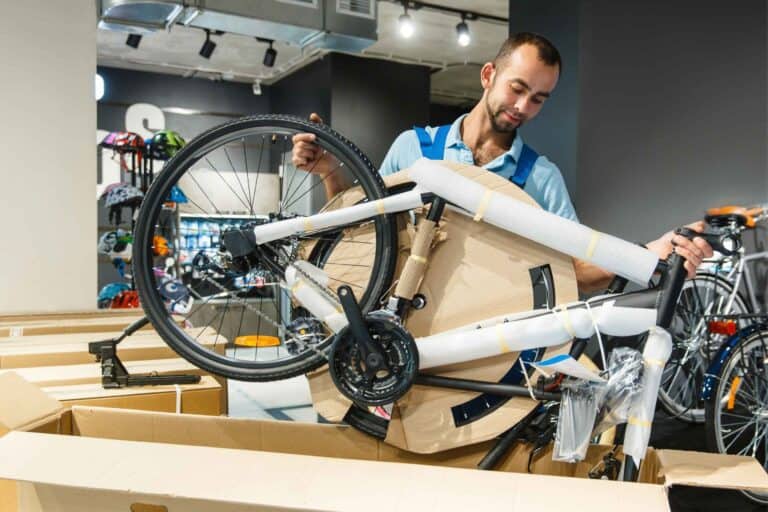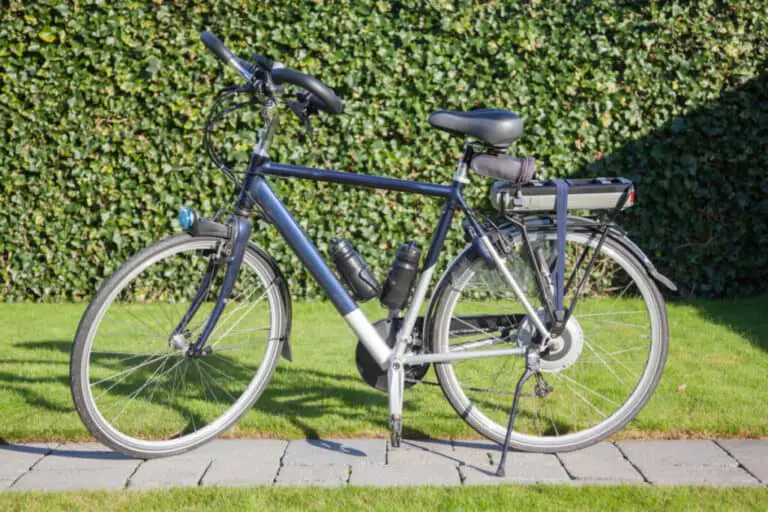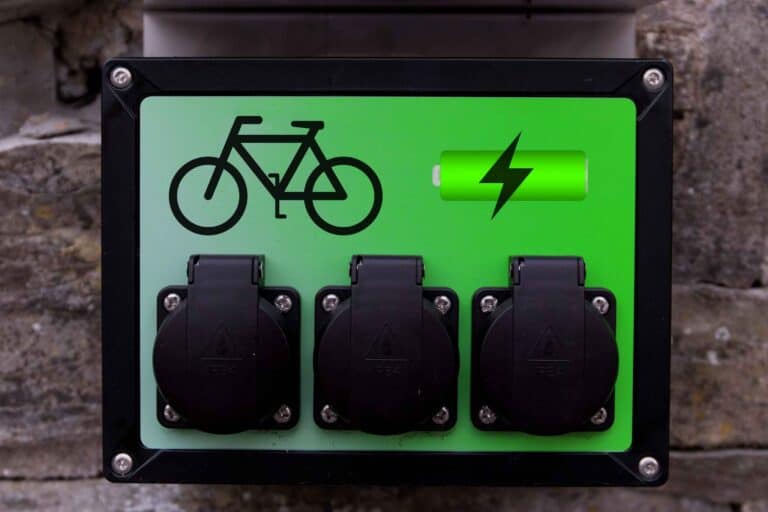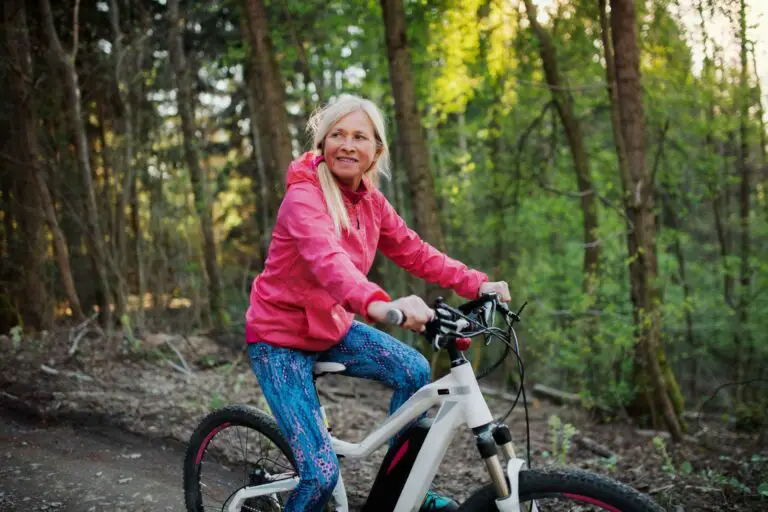eBike Tire Pressure (Best PSI For Every Riding Condition)
The ideal eBike tire pressure for an electric bike will accommodate traction and comfort while reducing the possibility of punctures and flat tires. It is essential to have the best eBike tire pressure for your particular riding conditions. So what should your eBike tire pressure be?
As a general rule, eBike tire pressure for a standard electric bike should be 70 psi. The ideal tire pressure varies based on the terrain. On roads, ideal eBike tire pressure ranges between 80-130 psi. On trails, it ranges between 40-70 psi. eBike tire pressure should be lowered to 25-50 psi on rocky or loose terrain.
Tire pressures can also be very different depending on the type of electric bike you own (fat, road, mountain, or hybrid), Factors like weather, temperature, the weight of the rider, and the rider’s riding style play a role in determining e-bike tire pressure. In this article, we are going to provide a guide on how to select the appropriate pressure that corresponds to your specific tire type while simultaneously optimizing for the terrain you ride on.
What Tire Pressure Should I Use for My eBike?
While there is no hard-and-fast rule for the “correct” tire pressure, the general guidelines that apply to standard bikes apply to eBikes as well. With this in mind, here are recommended tire pressures in psi (pounds per square inch) for different riding conditions.
| Standard Tire | Fat Tire | |
| Smooth road | 80-130 psi | 20-30 psi |
| Trail, off-road | 40-70 psi | 12-15 psi |
| Mountain | 25-50 psi | 10-12 psi |
| Snow, sand, mud | 5-20 psi | 2-10 psi |
For standard tires:
- For a smooth road, feel free to inflate your tires to their maximum recommended pressure. Since there is little risk of running over rocks and roots, you can inflate your tires to high pressures (80-130 psi) and still get a perfectly comfortable ride. Of course, a higher tire pressure also means lower traction, so you may have to work harder to keep your balance.
- In off-road conditions, the ground is looser, and you will need more traction. To accommodate this while still optimizing for speed, use a pressure range of 40-70 psi.
- On mountains, where the terrain is rough and rocky, high pressures are going to hurt. What’s worse, high pressures lead to less traction, which on mountain terrain could easily lead to injury. To avoid both situations, maintain a tire pressure of 25-50 psi: low enough to be comfortable and maintain a good grip on the ground while high enough to prevent punctures from rocks and sharp objects on the trail.
- While riding on soft surfaces like snow, sand, and mud, run your e-bike at low pressures (5-20 psi). In this sort of terrain, traction is everything.
Fat tires work a little differently. They need to be used at very low pressures (5-20 psi). They are most often ridden on soft, unstable terrain like snow and sand, where standard narrow tires aren’t typically used. If you’re riding them on solid terrain instead, simply increase their pressure to the higher end of their tire pressure range.
The correct pressure of a fat tire depends on its width. Counterintuitively, the wider the tire, the less pressure is needed. This is because fat tires have high volume but need lower pressure to operate.
Terrain type and tire type are not the only factors that come into play when choosing the best tire pressure for your riding situation. Here are a few other things to consider:
Wet Weather
Wet weather calls for lower pressure to ensure a larger contact area and more traction with the ground (or grip, as you’ll often hear it termed). According to LeedsBikes.com, “a tire pressure that is too high is often the primary cause for crashing when road conditions are wet.” So let a little air out of your tires to stay safe.

Cold Temperatures
Cold temperatures call for lower pressure. For every 10 degrees drop in temperature, the pressure in your tires needs to go down by two percent (source). So, again, let a little air out of your tires to stay safe.
Weight of Rider
The weight of the rider (and the weight of any cargo the rider is carrying) should also be considered.
- Heavier loads require higher tire pressures. When you have more weighing down on the tires, more pressure in the tires is needed to resist the weight. If you are riding with cargo, riding with a child, or just riding with a really heavy backpack, this is something to keep in mind.
- Lighter loads require lower tire pressures. If you’re a lighter person, you can get away with using lower pressures in your eBike tires and still have your tires carry you effectively.
Riding Style
Your riding style makes a difference in what tire pressure you should use too. For example, a rider who rides aggressively may prefer his tires at a higher pressure than someone who rides more slowly.
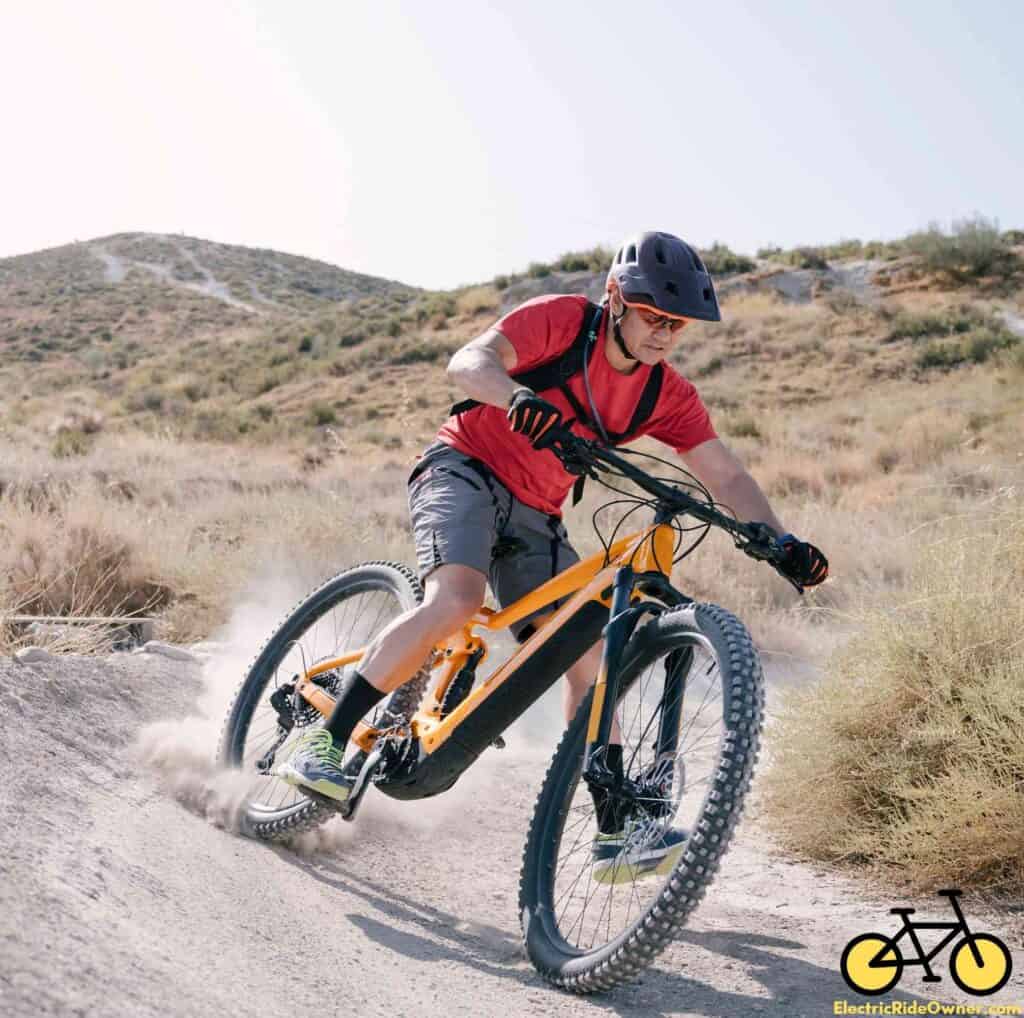
A higher tire pressure leads to a smaller contact area and less traction. On the other hand, a lower tire pressure leads to a larger contact area and more traction, but less control and more rolling resistance.
When choosing the proper tire pressure, you must consider the terrain, the type of tire, the weather, the temperature, the rider’s weight, and the rider’s riding style. If you can keep just a few of these factors in the forefront of your mind while pumping up your tires, you’ll feel the difference in your ride.
Ultimately, choosing the correct tire pressure is a balancing act. It takes compromise, intuition, and a lot of trial and error to find the appropriate eBike tire pressure for your electric bike. There’s no hard-and-fast rule; rather, the more comfortable you get with your e-bike, the better you’ll discern the proper tire pressure to use. For starters, just set your pressure based on the terrain and tire type; all other factors are generally minor in comparison.
How Do I Know What Tire Pressure to Use for My Bike?
As a whole, you will know what tire pressure to use for your bike by reading the pressure range stamped on the sidewall of your tire. You will see a minimum and maximum pressure in psi (pounds per square inch). The exact pressure you use will depend on your riding conditions.
Expert Tip: It might be hard to read! If it is, write it down someplace once you’ve figured it out the first time, so you don’t have to check again.
This pressure range is often wide, almost too wide to be helpful. You’ll have to do a lot of adjusting within the range to accommodate your riding conditions. Play around with it by testing out your e-bike a few times and asking yourself a few questions:
- How is your speed?
- Are your tires resistant to rolling?
- How comfortable are you? Are you being jolted when you hit bumps in the road?
- Do you feel you would be at risk of a puncture?
- How much traction do you have with the ground?
After a couple of test runs, you’ll inevitably settle on a tire pressure that feels right.
Keep in mind that every rider is different. A tire pressure that works for one rider could easily be too high or too low for another rider in the same terrain. Remember, the more you ride, the more intuitive it’ll become.
For safety reasons, never exceed the range written on the sidewall of your e-bike tire, i.e., don’t set pressures below the minimum or above the maximum manufacturer tire pressure specification. The owner’s manual for your electric bike will strongly warn you against exceeding the maximum, in particular. Overinflated tires wear out faster than normal and put you at risk for accidents. So stick to what’s written in the manual and check your tire pressure regularly.
Note to European riders: your pressure range might be written using the “bar” unit of measurement, not psi. One bar is equal to 14.5 psi. Here’s a handy converter if your range is written in a pressure unit you’re not familiar with.
What PSI Should My Back Bike Tire Be?
As a general rule, your back tire should be two psi higher than your front tire. This is to accommodate the fact that there is more weight placed on the back of most bikes. Raising the pressure of the back tire will help carry this weight.
Since 60% of our body weight is distributed to the back tire when we ride, raising the pressure of your back tire, even by a little bit, makes a big difference and helps with speed. For example: if your front tire is at 35 psi, your back tire should be at 37 psi. If your front tire is at 25 psi, your back tire should be at 27 psi, and so on.
This does not apply to all bikes. For example, some e-bikes, such as Rad Power Bikes, recommend that both bike tires be set at the same pressure. In addition, it is usually only experienced bikers who adjust their tires differently; if you are new to biking and don’t feel the difference or feel the need, don’t worry about it.
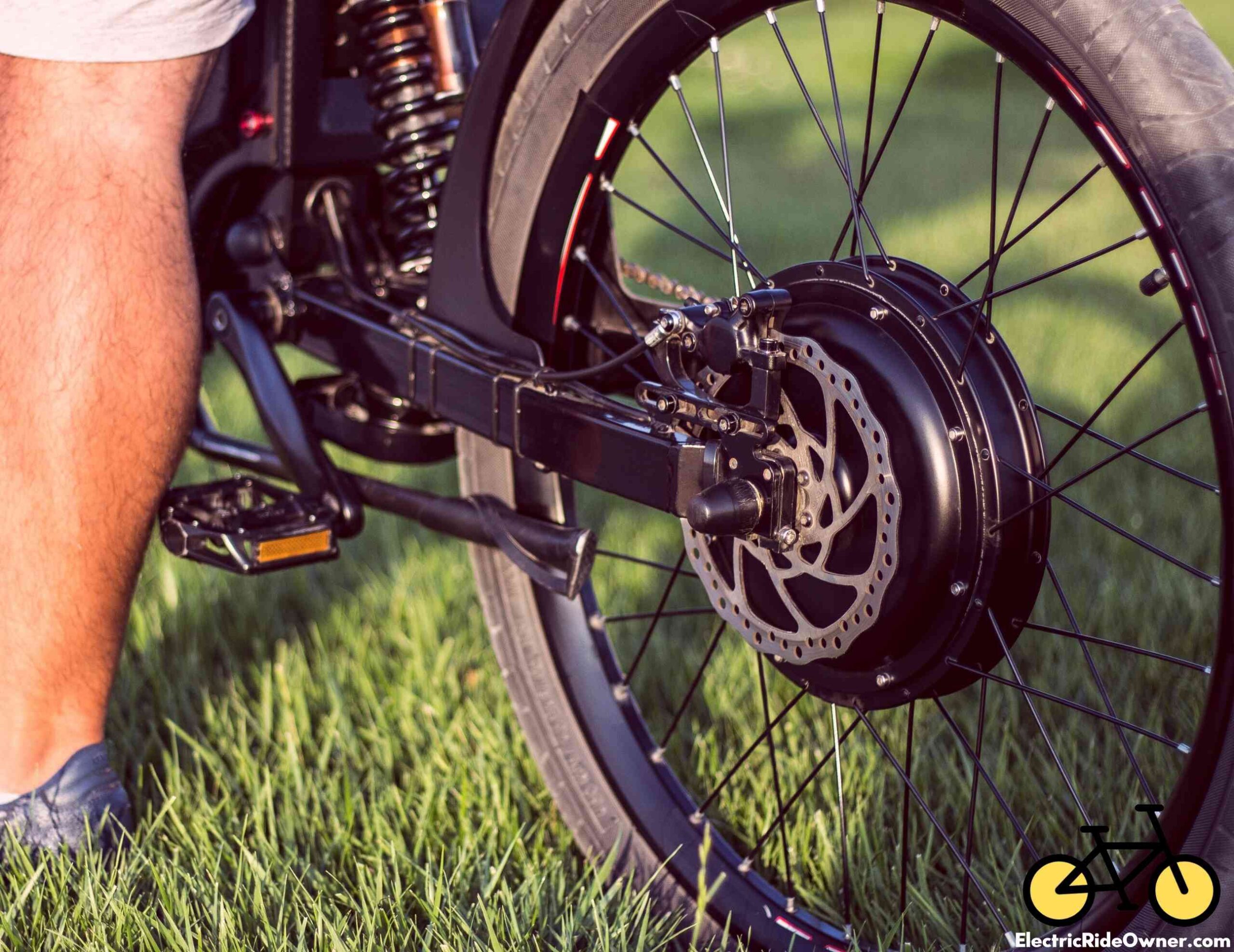
What Should My Fat-Tire eBike Pressure Be?
On average, the tire pressure for a fat-tire eBike should be 5-30 psi. This varies based on the exact width of the tires and the terrain you are riding on. Your tire pressure should be increased with thinner tires or on a harder surfaced terrain.
Best psi for a fat-tire eBike in every riding condition:
| Smooth road | 20-30 psi |
| Trail, off-road | 12-15 psi |
| Mountain | 10-12 psi |
| Snow, sand, mud | 2-10 psi |
Fat-tire eBikes are eBikes with oversized tires. They are ideal for riding on snow, sand, mud, and other soft and unstable terrain that regular bikes shouldn’t be used on.
Because their tires are so oversized, fat-tire eBikes operate at much lower pressures than standard-tire eBikes.The wider your tire is, the lower the tire pressure needs to be.
Always check the exact range of the specific fat eBike you own by looking for the numbers stamped on the sidewall of your tires. Some fat tires will only indicate the maximum tire pressure (i.e., max 25 psi), but most show a range. If you are riding in snow or sand, where tire pressures should run very low, you may want to invest in a more fine-tuned pressure gauge that can track pressures under two psi.
We recommend this pressure gauge that you can purchase on Amazon. It is fitted for the Presta valve system.
Unless it is ridden on hard terrain, a fat tire should not usually feel firm or solid. Instead, it should be soft enough for you to squeeze it. Fat-tire e-bikes are suitable for your overall comfort because they are soft and have excellent traction.
This is also why fat tires are more common on electric bikes than on standard bikes. Comfort plays a significant role in many people’s decision to go electric, and fat-tire eBikes are some of the most comfortable electric bikes you can buy.
Unfortunately, because fat tires are so soft, they are at increased risk for punctures. However, you can minimize this risk by installing Endurance Formula tire sealant or a tire liner. You can buy these items at a bike shop or online using the aforementioned links.
One final thing to take into account with fat-tire e-biking is whether your tires are tubed or tubeless. Tubed tires have a smaller contact area and require higher air pressures than tubeless tires. Therefore, if your tires are tubed, you will need to inflate them a few psi higher.
Tubeless tires are often preferred for fat tire biking since they yield more power and speed and decrease your chances of getting a flat tire. For this reason, riders using tubed tires are encouraged to upgrade their tires to tubeless instead.
What Should My Mountain eBike Tire Pressure Be?
On average, your mountain eBike tire pressure should be 25-50 psi. This varies based on rider weight, riding style, and trail conditions. Check the sidewall of your tire to find out the specific pressure range recommended by your manufacturer.
It can be painful to ride with your tires at high pressures in mountain terrain because you absorb impact every time your tires jolt off a rock. The resulting force will often make its way up to you. A relatively low pressure (25-50 psi) ensures that you stay comfortable and that your tires roll smoothly over rocks, stubs, and other obstacles instead of bouncing off them.
Try to figure out beforehand whether the trail you’re biking on will be smooth or bumpy so that you can plan accordingly. For smooth trails, use higher tire pressures. For rough trails, use lower tire pressures so that your ride doesn’t get skittish. However, make sure that the pressure doesn’t get too low. That is because soft tires are easy to puncture, and too much rolling resistance is not fun to work with, either.
Carry a hand pump or CO2 dispenser with you for longer rides on your e-bike. This will come in handy for when your tires need a little more air while you are in the middle of your ride. You do not want to be stuck on a mountain with a hopelessly deflated tire.
Most people prefer tubeless tires, and many riders now are converting their tubed tires to tubeless ones. That is because, on mountain trails, tubed tires tend to put you at risk of snakebite punctures (punctures that occur when a tube gets caught between an obstacle and the rim).
Note: With mountain eBiking, it is vital to set your back tire pressure higher than your front. The reason for this is that your back tire needs to sustain more impact. While you can lift your front tire out of the way of rocks or roots, you can’t stop your back tire from crashing down on them and getting hit with the brunt of the collision. A good rule of thumb is to set your back tire at four psi higher than your front bike tire. (if you’ve set the front tire at 40 psi, set the back tire at 44 psi, etc.)
Electric Mountain Bike Network is a fantastic resource to explore for more on the ins and outs of eBiking on mountainous terrain . Mountain eBiking is an excellent way to eBike either recreationally or competitively. Asking yourself a few quick questions about your tire pressure before riding will ensure you have the best possible experience.
“Pressure is good for tires, not people.”
-CherylRichardson.com
What Should My Hybrid eBike Tire Pressure Be?
On average, the ideal tire pressure for a hybrid eBike is 40-70 psi. Hybrid eBikes are used on mixed terrain, so be sure to adjust your tire pressure accordingly. For smooth terrain, find a tire pressure on the higher end of this range; for rough terrain, find a tire pressure in the lower end.
Hybrid electric bikes are a cross between road and mountain bikes. With that, it makes sense that their pressure range falls between the high pressure of thin road tires and the low pressure of thicker mountain tires. Their versatility in terms of terrain can be confusing when trying to set your tire pressure, but they are called hybrid bikes, after all.
Again, check the sidewall of your tire for the specific pressure range of your e-bike. Always note this ballpark range first before adjusting for your riding terrain. When you have this range in mind, you can then apply additional factors like the weight of the rider and the weather conditions.
For heavier loads, increase the pressure in your tires to lower rolling resistance. For wet weather conditions, reduce the pressure in your tires to gain traction.
What Should My Specialized eBike Tire Pressure Be?
As a general rule, your Specialized eBike tire pressure should be 35-65 psi for a mountain eBike, 110-125 psi for a road eBike, and 75-100 psi for a city electric bike. Check the pressure range stamped on your tire to determine the exact range for your specific e-bike.
| Type | Recommended pressure |
| Mountain | 35-65 psi |
| Road | 110-125 psi |
| City (700 x 28/30c) | 85-95 psi |
| City (700 x 32-38c) | 75-100 psi |
| City (700 x 42-50c) | 50-100 psi |
| Children | 35-65 psi |
This table was taken from the Specialized bike owner’s manual.
The rules for determining the best tire pressure for Specialized eBikes are the same as for any other eBike brand. Take into account the range, terrain, and tire type, and experiment until you’ve found the proper pressure for you.
What Should My Trek eBike Tire Pressure Be?
As a general rule, your Trek eBike tire pressure should be 35-65 psi for a mountain eBike, 110-125 psi for a road eBike, and 75-100 psi for a city electric bike. Check the pressure range stamped on your tire to determine the exact range for your specific electric bike.
“Use a tire pump with a gauge to make sure your tires are inflated within the recommended pressure range. Do not exceed the pressure limit as stated on the side of the tire or rim; whichever is lowest.” –Trek bicycle owner’s manual
To adjust tire pressure for your Trek eBike, follow the same general guidelines as you would with any other eBike brand. Higher tire pressures mean less rolling resistance and are suitable for paved roads and smooth surfaces. In comparison, lower pressures lead to more traction and comfort and are ideal for riding on mountains and off-roading situations.
How Do You Inflate an Electric Bike Tire?
Here is how to inflate an electric bike tire:
- Unscrew the dust cap that covers the valve.
- Attach an air pump to the valve.
- Pump in the air by pushing up and down on the handle until you’ve reached your desired pressure.
- Remove the pump from the valve and screw the dust cap back on.
As you can see, you inflate an electric bike tire the same way you inflate a standard bike tire.
There are three kinds of pumps you can use to pump air into your electric bike tires: floor pumps, hand pumps, and CO2 cartridges.
| Type | Description | Price |
| Floor pump (track pump) | The kind of pump you would keep at home. This is what most people picture when they think of an e-bike pump. | $13 – $188 |
| Hand pump (mini pump) | A smaller, more lightweight pump that you can bring with you on longer rides for whenever you need a quick fix. | $13 – $125 |
| CO2 cartridge | It serves the same function as a hand pump but is for one-time use only. | $34 for 16 gram 20-pack |
For everyday use, use a floor pump. A hand pump or CO2 canister becomes necessary only on longer rides during which your tires have more of a chance to deflate. Alternatively, you could choose to only own a hand pump, though the inflating process will then take longer than if you were to use a floor pump. For more about each of these pumps, see this video by EMBN.
The process of inflating an electric bike tire changes somewhat depending on whether your tire uses Schrader valves or Presta valves.
What is the difference? Presta valves are more common. They are skinnier and longer. Schrader valves are the same valves as you would see on a car. They are shorter and thicker.
There is also another type of valve called the Dunlop valve, but it is not seen or used often.
How is the process different? For Presta valves, be sure to unscrew the lock nut on the valve in addition to unscrewing the dust cap. Then, when you’re done pumping, be sure to screw the lock nut is closed before putting the dust cap back on.
Knowing which valve system your e-bike has is essential for inflating your tires as you cannot use a Schrader pump head on a Presta bike or vice versa. Luckily, dual attachments have been developed with swappable, twin, and adjustable pump heads that can inflate both Schrader and Presta valve systems.
If you have multiple electric bikes with different valve systems, you won’t need two separate pumps; simply purchase one pump with a dual attachment. You can also buy adapters if you already own the wrong kind of pump.
Remember that your tires are constantly deflating; the air is consistently seeping out, little by little. So inflate your tires regularly to counteract this and to avoid potentially getting a flat tire.
Check your tires every time before you ride. This doesn’t mean you have to use a pressure gauge, necessarily; just give them a quick squeeze to see if they might need more air. This will only take you a couple of seconds, and it could save you a lot of trouble down the road.
How to Inflate eBike Tires: Takeaways
- Same process as inflating a standard bike tire
- Two types of valve systems (Schrader and Presta) – make sure you have the right pump
- You should set your rear tire a few psi higher than your front tire to accommodate unequal weight distribution.
- You should always check your tires before you ride.
- Switching from tubed to tubeless tires will help you avoid pinch flats.
- You should always bring a hand pump or CO2 dispenser with you when you ride to keep tire pressure at its desired level.
- You should always check the pressure range recommended for your specific electric bike from your specific e-bike manufacturer. It is printed on the side of your tire.
Key Takeaways
Choose eBike Tire Pressure Based On Riding Terrain
- Terrain is perhaps the most important factor in deciding how much pressure you want in your tires.
- Road terrain → use high pressure.
- Off-road terrain → use moderate pressure.
- Mountain terrain → use moderate-to-low pressure.
- Snow, sand → use low pressure.
Choose eBike Tire Pressure Based On Tire Type
- Fat tires → use very low pressures.
- Hybrid wheels → use a cross between road and mountain pressures.
Other Factors to Consider
- Weather. Wet weather conditions → deflate your tires.
- Temperature. Colder temperature → deflate your tires.
- Weight of rider. Heavier rider → inflate your tires.
- Riding style. More aggressive rider → inflate your tires.
If you want to compare the features of Specialized Vado and Trek Allant, check out our published article “Specialized Vado Vs. Trek Allant (All Features Compared).”
